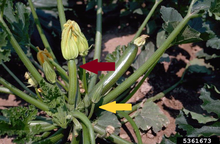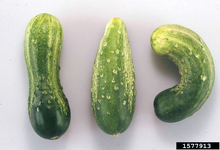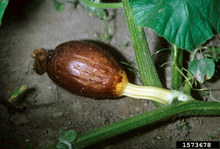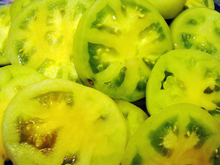It has been a hot few weeks in Minnesota, and people are reporting disappointing yields in their vegetable gardens. Bushy cucumber plants with no fruit, tomatoes not ripening, and beans with no flowers are being reported.
The causes behind many of these phenomena are related to persistent high temperatures. The high temperatures are affecting Minnesota’s vegetables in many different ways.
My plants look healthy, but I’m not getting any vegetables.
Potential issue 1: Too much fertilization
The brutal heat has made it tempting to baby our plants but giving some vegetables too much nitrogen results in lush green plants, but no harvestable vegetables. Vining vegetables are especially prone to this.
Make sure you are fertilizing appropriately for the weather and the plant you are trying to grow.
Potential issue 2: Hot day and nighttime temperatures cause flowers to drop
If you are still seeing flowers, but aren’t getting the tomatoes, peppers, beans or zucchini you are expecting, there can be a few heat-related factors in play.
The first is flower abortion: flowers form, but then die and fall off the plant before becoming fruit. This can happen in vegetables as well as other flowering garden plants. Flower abortion can happen at temperatures ranging from 75° F to 95° F.
Dropped flowers have been noticeable in tomatoes this year. Tomatoes produce new flowers often, and the flowers have a 50-hour-long window in which to be pollinated.
When tomatoes are exposed to sustained hot temperatures (more than 85° F in the day and 70° F at night), the tomato plant becomes stressed and burns through its energy stores. This changes the flowers, making it harder for them to be pollinated, and the blossom often drops out without pollination occurring. So during 50-hour periods that have hot days and especially hot nights, a round of tomato flowers are likely to drop off without pollinating.
You may start to notice something similar happening with green beans, which can also abort flowers in hot temperatures (over 95° F), especially if the soil is dry.
Potential issue 3: Hot temperatures change what type of flowers some vegetables produce
Vining vegetables in the cucurbit family (pumpkins, squash, melons, cucumbers, and the like) produce male and female flowers. Look at the base of the flower to tell the sex.
- Female cucurbit flowers will be swollen underneath in the area that will eventually become the pumpkin, zucchini, etc.
- Male flowers will have just a straight stem.
Depending on the variety of the vine crops, hot temperatures can change how many male and female flowers are present. Typically, high temperatures (over 90° F during the day and 70° F at night) develop more male flowers than female flowers. This means that we may be seeing zucchini plants with prolific flowers and few fruit, because the flowers we are seeing are all male, thus do not produce the part of zucchini we like to eat.
Potential Issue 4: Many bees don’t like it hot
In crops that depend on pollinators, such as members of the vine crop family, hot weather can impact bee activity, causing reduced fruit set. Just as we like to take it easy and rest in the shade on a hot day, so do many bees.
The ideal range for pollination for many species of bees is somewhere between 60° and 90° F, with hotter temperatures in this range promoting more pollination. Once it gets over 90° F, many bees slow down and pollinate less. This can be especially pronounced in crops like cucumbers, whose small flowers aren’t particularly attractive to many bees.
Pollination may occur, but not at a high enough level. This can lead to deformed cucumbers, summer squash and melons.
I can see the vegetables, they just aren’t getting ripe!
Potential Issue 1: Poor pollination results in fruit that can’t grow
Some growers of vine crops have noticed small squashes, pumpkins and melons forming but then rotting. You may think that this is caused by disease, as the small fruit are often breaking down, soft, and covered in mold.
A more common cause is poor pollination. Just as poor pollination can result in misshapen fruits, it can also result in fruit that form and then quickly die.
Green beans can have similar issues. During periods of hot weather bean flowers produce less pollen, which cascades into fewer, smaller pods containing fewer, smaller beans.
Potential Issue 2: Hot nights mean fruit doesn’t ripen
Tomato plants in many gardens are loaded with green fruit. Maybe grape tomato varieties are being harvested, but many slicing and beefsteak tomatoes seem to be holding onto green fruit that just won’t turn red.
Tomato ripening happens in two stages. In the first stage of ripening, the tomato becomes mature and is green, seeds form and the area around them becomes soft and gelatinous. (If you've ever had fried green tomatoes, you are eating a mature green tomato). In the second stage, the tomato fruit turns red.
The optimum temperature range for tomato maturation is between 68° F and 77° F, while the pigments that turn ripe tomatoes red aren’t produced above 85° F. Once we start to get some cooler nights, tomatoes will again have some hours in their ideal ripening temperature range, allowing for tomatoes to fully ripen and redden.
Potential issue 3: We need to be patient
Vegetables take time to get ripe. There may be nothing out of the ordinary going on in the garden. Tomatoes can take six to eight weeks to fully ripen and change color, and some vine crops, like pumpkins, can take just as long.
So, now what?
Unfortunately, there really isn’t much to be done but wait out the hot temperatures. Cool nights will solve many of these issues. Luckily for Minnesotans, the latest 30-day forecast from the National Weather Service is predicting cooler temperatures for August.
Make notes on how your vegetable varieties are performing, and consider trying a new heat-tolerant variety in the future.
Sources
Drost, D. (2020, April). Beans in the Garden. https://digitalcommons.usu.edu/cgi/viewcontent.cgi?article=1243&context=extension_curall
Johnson, G. (2015, July 24). Heat Effects on Vegetable and Fruit Crops. Weekly Crop Update. https://sites.udel.edu/weeklycropupdate/?p=8354
Lerner, R. (n.d.). Tomatoes Not Ripening? https://www.purdue.edu/hla/sites/yardandgarden/tomatoes-not-ripening/
Nair, A. (n.d.). Where are the Female Flowers? | Horticulture and Home Pest News. https://hortnews.extension.iastate.edu/2016/07-29/cucurbits.htm
Ozores-Hampton, M., Kiran, F., & McAvoy, G. (n.d.). Blossom Drop and Reduced Fruit Set in Tomato. https://swfrec.ifas.ufl.edu/docs/pdf/veg-hort/tomato-institute/presentations/ti2011/ozores.pdf
Runkle, E. (2018, March). Causes of Flower Bud Abortion. Greenhouse Product News, 42. https://gpnmag.com/article/causes-of-flower-bud-abortion/






